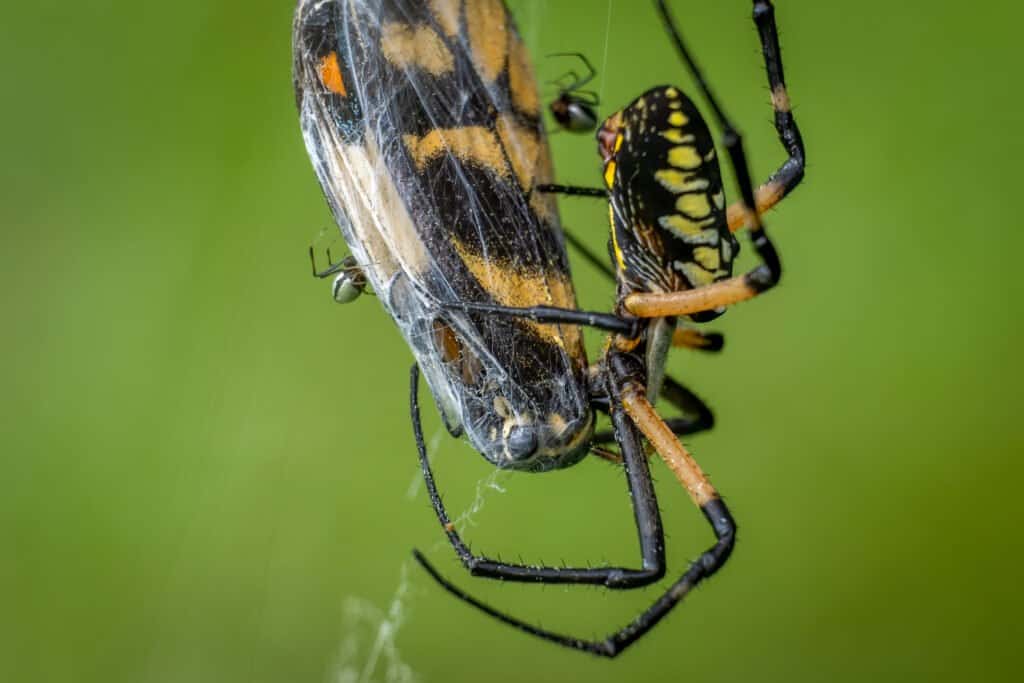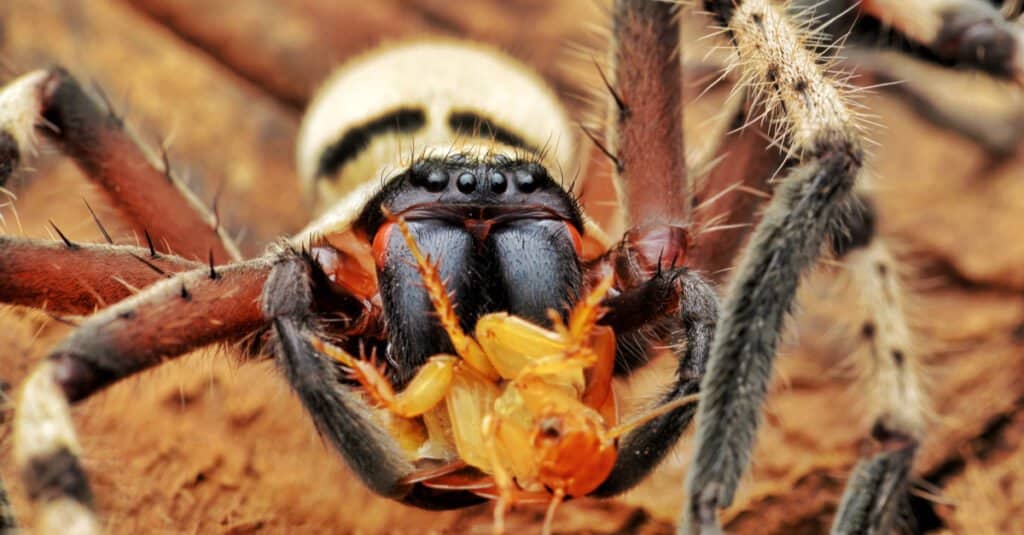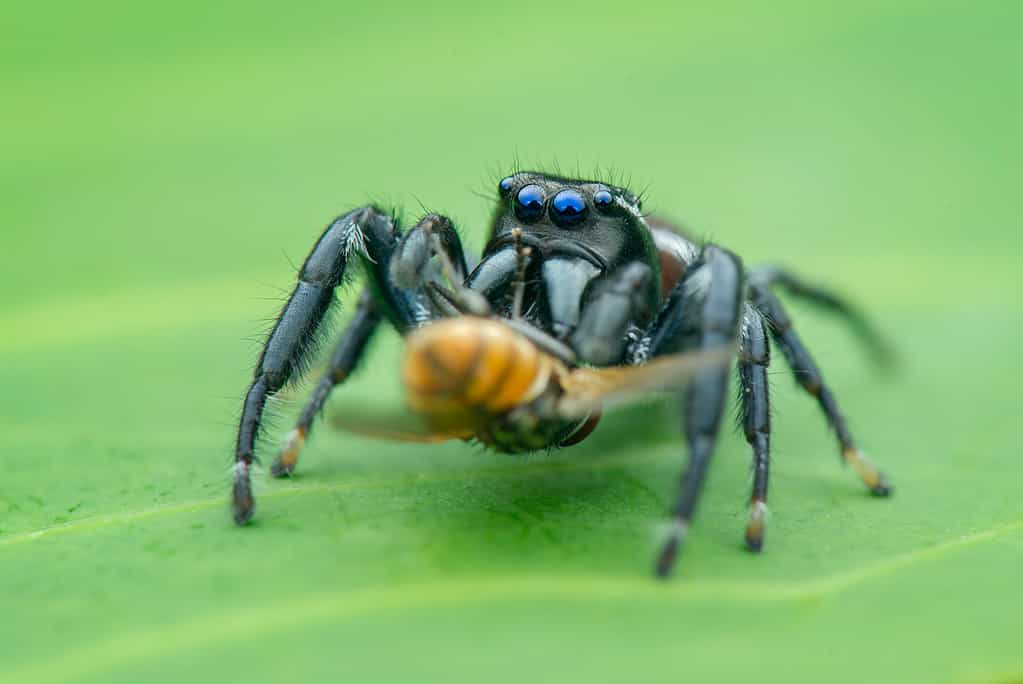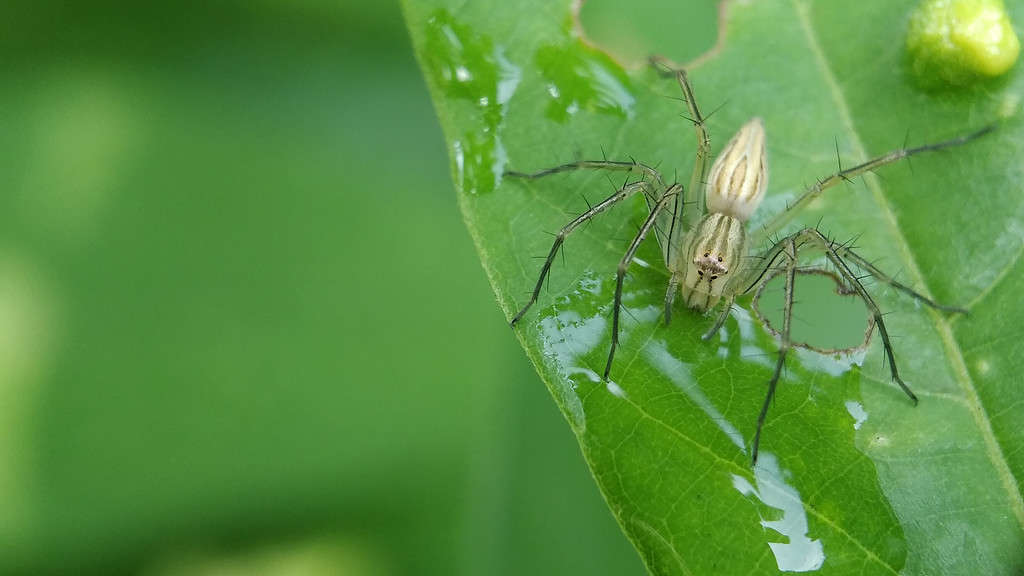Spiders, known for their incredible web-spinning skills and predatory nature, have long fascinated scientists. In this article, we delve into the intriguing question, ‘Can spiders taste food?’.
About Spiders

Spiders do not have tongues or teeth. Can spiders taste food?
©Vida Shams/Shutterstock.com
Spiders are incredible creatures that have been around for millions of years and have adapted to almost every environment on Earth. They are arachnids, meaning they have eight legs and two body segments. Spiders have an exoskeleton and use their silk to create webs and capture prey. They mainly feed on other insects, such as flies and mosquitoes.
Spiders come in a wide variety of shapes, sizes, and colors. Some species may have bright markings on their body, while others may be more subtle. Spiders can be found in almost any habitat, while others prefer certain types of environments. Some spiders can be quite large, while others are very small.
Spiders are also very diverse in terms of behavior. Some species are aggressive hunters, while others prefer to spin webs to capture prey. Spiders have also been known to use their webs to defend themselves and to travel from place to place.
Spiders have several adaptations that help them survive in their environment. They have very sensitive eyes that can detect movement from long distances. They also have a number of sensory organs on their legs, which allow them to detect vibrations and smells.
Spiders are an important part of the ecosystem, as they help to keep the population of other insect species in balance. They are also important pollinators, as they help to spread pollen to other plants.
Can Spiders Taste Food?

Spiders use their legs to taste their food.
©samray/Shutterstock.com
Spiders, fascinating creatures that they are, possess unique sensory abilities that allow them to navigate and interact with their environment in extraordinary ways. While it may seem peculiar to us humans, spiders not only taste but also smell through specialized sensory organs located on their legs and pedipalps. These remarkable appendages serve as more than just tools for movement. They act as intricate receptors that enable spiders to explore the world around them.
Imagine for a moment being able to experience flavors and scents simply by touching objects or surfaces with your limbs. This is precisely how spiders perceive their surroundings. They utilize these leg-based sensors, which detect chemical cues present in the air or on various surfaces. Through this remarkable ability, spiders can discern potential sources of food or identify mates from afar. They rely on an entire array of tastes and odors that we can only begin to fathom.
Can Spiders Hear?

Did you know that spiders can taste food with their legs and hear with their hair?
©Niney Azman/Shutterstock.com
Arachnids have astonishing capabilities. Spiders possess an unconventional form of hearing, or rather vibration detection, achieved through tiny hairs and slits distributed across their bodies. By sensing subtle vibrations traveling through solid materials such as leaves or webs, spiders gain crucial information about their environment and any potential threats or opportunities lurking nearby.
Consider what it would be like if we could hear not with our ears but instead with our hair – perceiving sound waves directly through strands on our heads. Such a concept might seem utterly foreign to us humans, yet this is precisely how spiders interpret the world.
Can Spiders Feel?

Yes, spiders can taste their food. They can also feel, smell and hear!
©iStock.com/RobertDowner
Spiders possess an extremely sensitive ability to recognize vibrations, which allows them to differentiate between prey and distinguish between potential mates. This sensitivity is so precise that spiders can identify the species of insect that is coming into contact with their web. They can literally tell the difference between a honeybee hitting the web and a moth.
Furthermore, males of web-building species tend to use this capability to their advantage when attempting to court a female, as they can communicate with her by plucking her web with a species-specific pattern. Otherwise, they risk being eaten instead of becoming her partner.
What Kind of Foods Do Spiders Eat?

Most spiders are carnivores and eat insects, invertebrates, and sometimes other spiders.
©DWI YULIANTO/Shutterstock.com
Spiders have a variety of diets, depending on the species. Most spiders are carnivores that feed on insects, while a few others are omnivores that consume both vegetation and insects.
One of the most common types of spiders is the jumping spider. This species typically eats a variety of insects, such as flies, moths, and mosquitoes. They use their long legs to pounce on their prey and quickly subdue them with their venom. Some species of jumping spiders also eat pollen, nectar, and sap.
Another common species of spider is the wolf spider. This species usually feeds on small insects, such as ants and termites. They hunt their prey by using their keen eyesight and sense of smell. Their venom is used to immobilize their victims before consuming them.
The orb weaver spider is another type of spider that feeds on other insects. This species typically eats flies, moths, and other small insects. They use their webs to capture their prey, and, like the jumping spider, they use their venom to paralyze their victims before consuming them.
The tarantula is another type of spider that typically feeds on insects, such as crickets, grasshoppers, and other small invertebrates. They use their large fangs to inject venom into their victims and then consume them.
Finally, the harvestman spider is a species that feeds on small insects, such as ants, and other small invertebrates, like worms and snails.
How Do Spiders Eat?

Using their venom to paralyze and liquefy their prey is how spiders manage to eat without teeth.
©Milan Zygmunt/Shutterstock.com
Spiders have an interesting way of consuming their food. They use their fangs (chelicerae) to pierce the body of their prey and inject a venomous toxin that paralyzes it. Once the prey is immobilized, the venom turns the insect into a liquid.
Once the prey has been liquefied, the spider sucks it into its digestive system. Inside the digestive system, the spider’s stomach acid breaks down the food into molecules that can be absorbed and used by its body. The leftover indigestible material is then expelled as waste.
How Do Spiders Drink?

Spiders taste their food. They can also drink water from many different sources, including your sink.
©Husain Arifin/iStock via Getty Images
Do spiders drink water? The short answer is yes. But how? While they don’t drink in the same way as humans, spiders will take in water from their environment in order to survive. Contrary to popular belief, spiders do not suck water up using their fangs like straws. They have tiny muscles behind their chelicerae that suck water up very slowly. Some spiders take over an hour to drink water!
Spiders typically get the majority of their liquid from their prey but will also drink from sources of water in their environment, such as ponds, rivers, and rain. They can also drink water directly from their webs, such as when dew condensates there.
In some cases, spiders may also drink from puddles that form on leaves or other objects. This is why you might occasionally see a spider perched on top of a leaf after a rain.
So, while spiders don’t drink in the same way humans do, they are still able to get the moisture they need to survive in their environment. This allows them to thrive in a wide range of habitats, from deserts to rainforests.
Do Spiders Have Excellent Vision?

Most spiders have eight eyes, but several types have six. Not all spiders have excellent vision.
©Professional Fine Art/Shutterstock.com
Many spiders have eight eyes that have distinct patterns that help experts identify them. Several types of spiders have six eyes, including spitting spiders, cellar spiders, and recluse spiders. Although they have numerous eyes, spiders usually have poor eyesight compared to humans. This isn’t a problem for spiders that spin webs and catch their food since the prey comes to them.
However, spiders that hunt for their food have excellent vision. They need to be able to see well to run after their prey and jump on it. Jumping spiders, flower spiders, and wolf spiders are examples of spiders that have acute eyesight. Wolf spiders have great vision in both daylight and at night.
The photo featured at the top of this post is © common human/Shutterstock.com
Thank you for reading! Have some feedback for us? Contact the AZ Animals editorial team.







